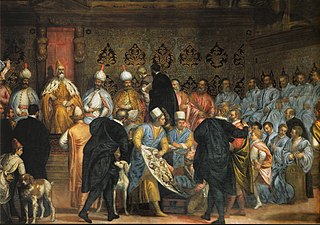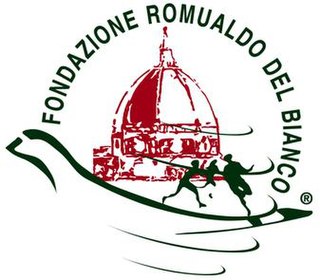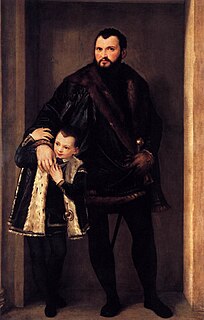
The Uffizi Gallery is a prominent art museum located adjacent to the Piazza della Signoria in the Historic Centre of Florence in the region of Tuscany, Italy. One of the most important Italian museums and the most visited, it is also one of the largest and best known in the world and holds a collection of priceless works, particularly from the period of the Italian Renaissance.

Antonio del Pollaiuolo, also known as Antonio di Jacopo Pollaiuolo or Antonio Pollaiuolo, was an Italian painter, sculptor, engraver and goldsmith during the Italian Renaissance.

Paolo Caliari, known as Paolo Veronese, was an Italian Renaissance painter based in Venice, known for extremely large history paintings of religion and mythology, such as The Wedding at Cana (1563) and The Feast in the House of Levi (1573). Included with Titian, a generation older, and Tintoretto, a decade senior, Veronese is one of the "great trio that dominated Venetian painting of the cinquecento" and the Late Renaissance in the 16th century. Known as a supreme colorist, and after an early period with Mannerism, Paolo Veronese developed a naturalist style of painting, influenced by Titian.

The Galleria dell'Accademia di Firenze, or "Gallery of the Academy of Florence", is an art museum in Florence, Italy. It is best known as the home of Michelangelo's sculpture David. It also has other sculptures by Michelangelo and a large collection of paintings by Florentine artists, mostly from the period 1300–1600, the Trecento to the Late Renaissance. It is smaller and more specialized than the Uffizi, the main art museum in Florence. It adjoins the Accademia di Belle Arti or academy of fine arts of Florence, but despite the name has no other connection with it.

Sebastiano Ricci was an Italian painter of the late Baroque school of Venice. About the same age as Piazzetta, and an elder contemporary of Tiepolo, he represents a late version of the vigorous and luminous Cortonesque style of grand manner fresco painting.
The Battle of San Romano is a set of three paintings by the Florentine painter Paolo Uccello depicting events that took place at the Battle of San Romano between Florentine and Sienese forces in 1432. They are significant as revealing the development of linear perspective in early Italian Renaissance painting, and are unusual as a major secular commission. The paintings are in egg tempera on wooden panels, each over 3 metres long. According to the National Gallery, London, the panels were commissioned by a member of the Bartolini Salimbeni family in Florence sometime between 1435 and 1460. The paintings were much admired in the 15th century; Lorenzo de' Medici so coveted them that he purchased one and had the remaining two forcibly removed to the Palazzo Medici. They are now divided between three collections, the National Gallery, the Galleria degli Uffizi, Florence, and the Musée du Louvre, Paris.

Justina of Padua is a Christian saint and a patroness of Padua. Her feast day is October 7. She is often confused with Justina of Antioch. She was devoted to religion from her earliest years and took the vow of perpetual virginity. When she was brought before Maximian the prefect, she remained firm against all attacks. The prefect caused her to be slain with the sword.

Francesco Curradi or Currado was an Italian painter of the style described as Counter-Maniera or Counter-Mannerism, born and active in Florence.

Carlo Cannovaro Caliari (1570–1596) was an Italian artist of the Renaissance period. He is also known as Carletto. The youngest son of Paolo Veronese, Caliari was active mainly in Venice, where he worked and inherited the studio of his far more famous father, and later worked along with his brother Gabriele and his uncle, Benedetto. His name is attached to several large pictures of banquets in Veronese's style. Alessandro Turchi worked briefly under him.

The Portrait of Daniele Barbaro is a painting by the Italian Renaissance master Paolo Veronese in the Rijksmuseum Amsterdam. Daniele Barbaro was a member of the Venetian aristocracy. He was an important prelate, humanist and architectural theorist, who commissioned a number of works from Veronese. Veronese had been involved directly with Barbaro and his brother Marcantonio Barbaro, decorating the Villa Barbaro, Maser, which Palladio designed.

The Romualdo Del Bianco Foundation is an Italian non-profit organization established in Florence, Italy, on November 3, 1998 by Paolo Del Bianco - who entitled the Foundation to his father Romualdo. The Foundation is funded privately by Paolo Del Bianco. The Foundation promotes tourism awareness and dialogue between cultures. At the moment, the Foundation network counts over 450 academic institutions and universities in 60 countries in 5 continents.

The Abbey of Santa Giustina is a 10th-century Benedictine abbey complex located in front of the Prato della Valle in central Padua, region of Veneto, Italy. Adjacent to the former monastery is the basilica church of Santa Giustina, initially built in the 6th century, but whose present form derives from a 17th-century reconstruction.

Portrait of a Knight of Malta is a c.1515 oil on canvas painting by Titian of a knight belonging to the Order of Malta. It is now in the Uffizi in Florence. The last bead of the rosary held by the knight bears the number XXXV (35), showing the subject's age at the time of the portrait. W.F. Dickes. argued that he was Stefano Colonna, the condottiero who led the republican resistance during the siege of Florence. cited in
Paolo del Sera was a Florentine artist and art connoisseur of Venetian art who is best known for his correspondence with Leopoldo de 'Medici. He is said to have trained under Domenico Passignano and in Venice under Tiberio Tinelli, and respected as a portrait painter.

Annunciation is an oil on canvas painting, now in the Uffizi in Florence. It and The Martyrdom of Saint Justina were bought in Venice by Paolo del Sera, intermediary and agent for cardinal Leopoldo de' Medici in 1654.

Holy Family with Saint Catherine and Saint John the Baptist is an oil on canvas painting by Paolo Veronese, now in the Uffizi in Florence. Its dating is debated, varying between his early period and his late one, the latter influenced by Tintoretto, with the latter the majority view, placing it in c.1562-1565. Some early copies survive, one on parchment by Carlo Loth, one by Gian Antonio Guardi and a third of almost exactly the same dimensions as the original, possibly autograph.

Portrait of Iseppo da Porto and his son Adriano is a c.1555 oil on canvas painting by Paolo Veronese, now in the Contini Bonacossi collection, on long-term loan to the Uffizi in Florence. Veronese also decorated Porto's Palazzo Porto in Vicenza, designed by Andrea Palladio and completed in 1552.

Saint Anthony Preaching to the Fish is a 1580–1585 oil on canvas painting of Anthony of Padua by Paolo Veronese, now in the Galleria Borghese in Rome. Its original location is unknown, though its medium dimensions of 104 centimetres (41 in) by 150 centimetres (59 in) mean it may have been painted for the side wall of a chapel or as part of a cycle of paintings for a small school (scuola) in Venice. It probably entered the collection of Cardinal Scipione Borghese as a 1607 gift from Francesco Barbaro.

The Finding of Moses is a 1580 oil on canvas painting by Paolo Veronese of the finding of Moses, which has been in the Musee des Beaux Arts de Dijon since 1812. Its attribution to Veronese is early, with Lépicié stating it was "painted by the artist at the height of his powers", though Louis Clément de Ris argued it was a copy in 1861. It is now thought to be largely autograph with studio assistance as argued by Florence Ingersoll-Smouse in 1928, Bernard Berenson in 1932 and 1936 and Giuseppe Fiocco in 1934.

Madonna and Child with Saints is a 1588 oil on canvas painting by Annibale Carracci, now in the Gemäldegalerie Alte Meister in Dresden. Signed and dated by the artist, it is also known as Madonna and Child with Saints Francis, Matthew and John the Baptist, Madonna and Child Enthroned with Saint Matthew and the St Matthew Madonna.


















